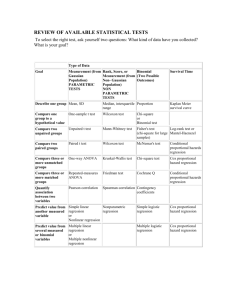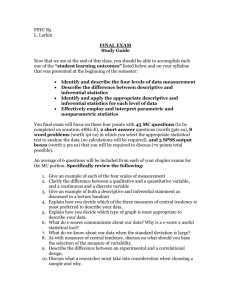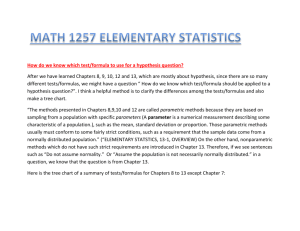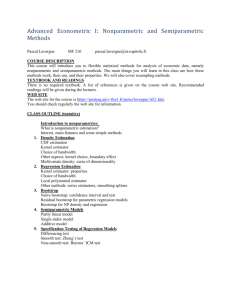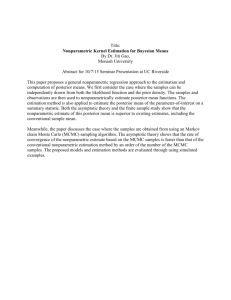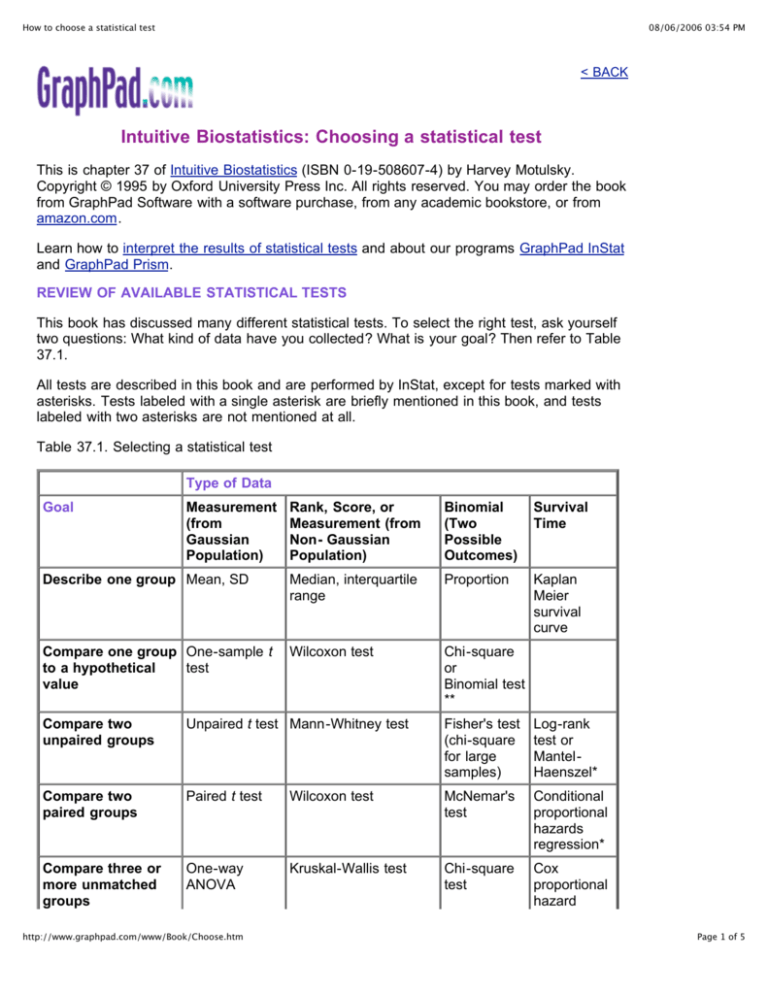
How to choose a statistical test
08/06/2006 03:54 PM
< BACK
Intuitive Biostatistics: Choosing a statistical test
This is chapter 37 of Intuitive Biostatistics (ISBN 0-19-508607-4) by Harvey Motulsky.
Copyright © 1995 by Oxford University Press Inc. All rights reserved. You may order the book
from GraphPad Software with a software purchase, from any academic bookstore, or from
amazon.com.
Learn how to interpret the results of statistical tests and about our programs GraphPad InStat
and GraphPad Prism.
REVIEW OF AVAILABLE STATISTICAL TESTS
This book has discussed many different statistical tests. To select the right test, ask yourself
two questions: What kind of data have you collected? What is your goal? Then refer to Table
37.1.
All tests are described in this book and are performed by InStat, except for tests marked with
asterisks. Tests labeled with a single asterisk are briefly mentioned in this book, and tests
labeled with two asterisks are not mentioned at all.
Table 37.1. Selecting a statistical test
Type of Data
Goal
Measurement
(from
Gaussian
Population)
Rank, Score, or
Measurement (from
Non- Gaussian
Population)
Binomial
(Two
Possible
Outcomes)
Survival
Time
Describe one group Mean, SD
Median, interquartile
range
Proportion
Kaplan
Meier
survival
curve
Compare one group One-sample t
to a hypothetical
test
value
Wilcoxon test
Chi-square
or
Binomial test
**
Compare two
unpaired groups
Unpaired t test Mann-Whitney test
Fisher's test
(chi-square
for large
samples)
Log-rank
test or
MantelHaenszel*
Compare two
paired groups
Paired t test
Wilcoxon test
McNemar's
test
Conditional
proportional
hazards
regression*
Compare three or
more unmatched
groups
One-way
ANOVA
Kruskal-Wallis test
Chi-square
test
Cox
proportional
hazard
http://www.graphpad.com/www/Book/Choose.htm
Page 1 of 5
How to choose a statistical test
08/06/2006 03:54 PM
regression**
Compare three or
more matched
groups
Repeatedmeasures
ANOVA
Friedman test
Cochrane
Q**
Conditional
proportional
hazards
regression**
Quantify
association
between two
variables
Pearson
correlation
Spearman correlation
Contingency
coefficients**
Predict value from
another measured
variable
Simple linear
regression
or
Nonlinear
regression
Nonparametric
regression**
Simple
logistic
regression*
Cox
proportional
hazard
regression*
Predict value from
several measured
or binomial
variables
Multiple linear
regression*
or
Multiple
nonlinear
regression**
Multiple
logistic
regression*
Cox
proportional
hazard
regression*
REVIEW OF NONPARAMETRIC TESTS
Choosing the right test to compare measurements is a bit tricky, as you must choose
between two families of tests: parametric and nonparametric. Many -statistical test are based
upon the assumption that the data are sampled from a Gaussian distribution. These tests are
referred to as parametric tests. Commonly used parametric tests are listed in the first column
of the table and include the t test and analysis of variance.
Tests that do not make assumptions about the population distribution are referred to as
nonparametric- tests. You've already learned a bit about nonparametric tests in previous
chapters. All commonly used nonparametric tests rank the outcome variable from low to high
and then analyze the ranks. These tests are listed in the second column of the table and
include the Wilcoxon, Mann-Whitney test, and Kruskal-Wallis tests. These tests are also
called distribution-free tests.
CHOOSING BETWEEN PARAMETRIC AND NONPARAMETRIC TESTS: THE EASY
CASES
Choosing between parametric and nonparametric tests is sometimes easy. You should
definitely choose a parametric test if you are sure that your data are sampled from a
population that follows a Gaussian distribution (at least approximately). You should definitely
select a nonparametric test in three situations:
• The outcome is a rank or a score and the population is clearly not Gaussian.
Examples include class ranking of students, the Apgar score for the health of newborn
babies (measured on a scale of 0 to IO and where all scores are integers), the visual
analogue score for pain (measured on a continuous scale where 0 is no pain and 10 is
unbearable pain), and the star scale commonly used by movie and restaurant critics (*
is OK, ***** is fantastic).
• Some values are "off the scale," that is, too high or too low to measure. Even if the
http://www.graphpad.com/www/Book/Choose.htm
Page 2 of 5
How to choose a statistical test
08/06/2006 03:54 PM
population is Gaussian, it is impossible to analyze such data with a parametric test
since you don't know all of the values. Using a nonparametric test with these data is
simple. Assign values too low to measure an arbitrary very low value and assign
values too high to measure an arbitrary very high value. Then perform a nonparametric
test. Since the nonparametric test only knows about the relative ranks of the values, it
won't matter that you didn't know all the values exactly.
• The data ire measurements, and you are sure that the population is not distributed in
a Gaussian manner. If the data are not sampled from a Gaussian distribution, consider
whether you can transformed the values to make the distribution become Gaussian.
For example, you might take the logarithm or reciprocal of all values. There are often
biological or chemical reasons (as well as statistical ones) for performing a particular
transform.
CHOOSING BETWEEN PARAMETRIC AND NONPARAMETRIC TESTS: THE HARD
CASES
It is not always easy to decide whether a sample comes from a Gaussian population.
Consider these points:
• If you collect many data points (over a hundred or so), you can look at the distribution
of data and it will be fairly obvious whether the distribution is approximately bell
shaped. A formal statistical test (Kolmogorov-Smirnoff test, not explained in this book)
can be used to test whether the distribution of the data differs significantly from a
Gaussian distribution. With few data points, it is difficult to tell whether the data are
Gaussian by inspection, and the formal test has little power to discriminate between
Gaussian and non-Gaussian distributions.
• You should look at previous data as well. Remember, what matters is the distribution
of the overall population, not the distribution of your sample. In deciding whether a
population is Gaussian, look at all available data, not just data in the current
experiment.
• Consider the source of scatter. When the scatter comes from the sum of numerous
sources (with no one source contributing most of the scatter), you expect to find a
roughly Gaussian distribution.
When in doubt, some people choose a parametric test (because they aren't sure the
Gaussian assumption is violated), and others choose a nonparametric test (because
they aren't sure the Gaussian assumption is met).
CHOOSING BETWEEN PARAMETRIC AND NONPARAMETRIC TESTS: DOES IT
MATTER?
Does it matter whether you choose a parametric or nonparametric test? The answer depends
on sample size. There are four cases to think about:
• Large sample. What happens when you use a parametric test with data from a
nongaussian population? The central limit theorem (discussed in Chapter 5) ensures
that parametric tests work well with large samples even if the population is nonGaussian. In other words, parametric tests are robust to deviations from Gaussian
distributions, so long as the samples are large. The snag is that it is impossible to say
how large is large enough, as it depends on the nature of the particular non-Gaussian
distribution. Unless the population distribution is really weird, you are probably safe
choosing a parametric test when there are at least two dozen data points in each
group.
• Large sample. What happens when you use a nonparametric test with data from a
Gaussian population? Nonparametric tests work well with large samples from Gaussian
http://www.graphpad.com/www/Book/Choose.htm
Page 3 of 5
How to choose a statistical test
08/06/2006 03:54 PM
populations. The P values tend to be a bit too large, but the discrepancy is small. In
other words, nonparametric tests are only slightly less powerful than parametric tests
with large samples.
• Small samples. What happens when you use a parametric test with data from
nongaussian populations? You can't rely on the central limit theorem, so the P value
may be inaccurate.
• Small samples. When you use a nonparametric test with data from a Gaussian
population, the P values tend to be too high. The nonparametric tests lack statistical
power with small samples.
Thus, large data sets present no problems. It is usually easy to tell if the data come from a
Gaussian population, but it doesn't really matter because the nonparametric tests are so
powerful and the parametric tests are so robust. Small data sets present a dilemma. It is
difficult to tell if the data come from a Gaussian population, but it matters a lot. The
nonparametric tests are not powerful and the parametric tests are not robust.
ONE- OR TWO-SIDED P VALUE?
With many tests, you must choose whether you wish to calculate a one- or two-sided P value
(same as one- or two-tailed P value). The difference between one- and two-sided P values
was discussed in Chapter 10. Let's review the difference in the context of a t test. The P
value is calculated for the null hypothesis that the two population means are equal, and any
discrepancy between the two sample means is due to chance. If this null hypothesis is true,
the one-sided P value is the probability that two sample means would differ as much as was
observed (or further) in the direction specified by the hypothesis just by chance, even though
the means of the overall populations are actually equal. The two-sided P value also includes
the probability that the sample means would differ that much in the opposite direction (i.e.,
the other group has the larger mean). The two-sided P value is twice the one-sided P value.
A one-sided P value is appropriate when you can state with certainty (and before collecting
any data) that there either will be no difference between the means or that the difference will
go in a direction you can specify in advance (i.e., you have specified which group will have
the larger mean). If you cannot specify the direction of any difference before collecting data,
then a two-sided P value is more appropriate. If in doubt, select a two-sided P value.
If you select a one-sided test, you should do so before collecting any data and you need to
state the direction of your experimental hypothesis. If the data go the other way, you must be
willing to attribute that difference (or association or correlation) to chance, no matter how
striking the data. If you would be intrigued, even a little, by data that goes in the "wrong"
direction, then you should use a two-sided P value. For reasons discussed in Chapter 10, I
recommend that you always calculate a two-sided P value.
PAIRED OR UNPAIRED TEST?
When comparing two groups, you need to decide whether to use a paired test. When
comparing three or more groups, the term paired is not apt and the term repeated measures
is used instead.
Use an unpaired test to compare groups when the individual values are not paired or
matched with one another. Select a paired or repeated-measures test when values represent
repeated measurements on one subject (before and after an intervention) or measurements
on matched subjects. The paired or repeated-measures tests are also appropriate for
repeated laboratory experiments run at different times, each with its own control.
http://www.graphpad.com/www/Book/Choose.htm
Page 4 of 5
How to choose a statistical test
08/06/2006 03:54 PM
You should select a paired test when values in one group are more closely correlated with a
specific value in the other group than with random values in the other group. It is only
appropriate to select a paired test when the subjects were matched or paired before the data
were collected. You cannot base the pairing on the data you are analyzing.
FISHER'S TEST OR THE CHI-SQUARE TEST?
When analyzing contingency tables with two rows and two columns, you can use either
Fisher's exact test or the chi-square test. The Fisher's test is the best choice as it always
gives the exact P value. The chi-square test is simpler to calculate but yields only an
approximate P value. If a computer is doing the calculations, you should choose Fisher's test
unless you prefer the familiarity of the chi-square test. You should definitely avoid the chisquare test when the numbers in the contingency table are very small (any number less than
about six). When the numbers are larger, the P values reported by the chi-square and
Fisher's test will he very similar.
The chi-square test calculates approximate P values, and the Yates' continuity correction is
designed to make the approximation better. Without the Yates' correction, the P values are
too low. However, the correction goes too far, and the resulting P value is too high.
Statisticians give different recommendations regarding Yates' correction. With large sample
sizes, the Yates' correction makes little difference. If you select Fisher's test, the P value is
exact and Yates' correction is not needed and is not available.
REGRESSION OR CORRELATION?
Linear regression and correlation are similar and easily confused. In some situations it makes
sense to perform both calculations. Calculate linear correlation if you measured both X and Y
in each subject and wish to quantity how well they are associated. Select the Pearson
(parametric) correlation coefficient if you can assume that both X and Y are sampled from
Gaussian populations. Otherwise choose the Spearman nonparametric correlation coefficient.
Don't calculate the correlation coefficient (or its confidence interval) if you manipulated the X
variable.
Calculate linear regressions only if one of the variables (X) is likely to precede or cause the
other variable (Y). Definitely choose linear regression if you manipulated the X variable. It
makes a big difference which variable is called X and which is called Y, as linear regression
calculations are not symmetrical with respect to X and Y. If you swap the two variables, you
will obtain a different regression line. In contrast, linear correlation calculations are
symmetrical with respect to X and Y. If you swap the labels X and Y, you will still get the
same correlation coefficient.
Learn how to interpret the results of statistical tests and about our programs GraphPad InStat
and GraphPad Prism. Visit the GraphPad home page
http://www.graphpad.com/www/Book/Choose.htm
Page 5 of 5



